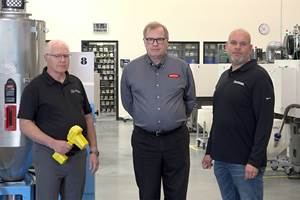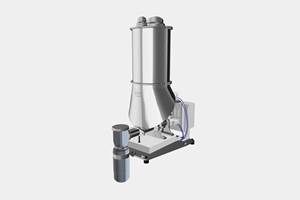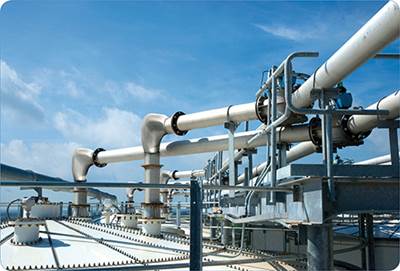Auxiliaries at NPE: News in Materials Handling, Cooling, Granulating, Welding, Testing, Decorating
NPE2012 News Wrap Up
Auxiliary equipment takes in a broad range of functions, from materials preparation to post-mold finishing.
Auxiliary equipment takes in a broad range of functions, from materials preparation to post-mold finishing. NPE2012 held significant news in virtually all areas. For a complete picture of the news, see our March show preview, which contained information on many new entries that isn’t repeated here.
SMARTER DRYING
One of the most dramatic innovations at the show was the new MoistureMaster from Novatec Inc. As explained in detail in our March Close Up, this is the first device to measure actual moisture content in resin pellets in the dryer hopper in real time. It takes the place of inferring moisture content from temperature or dewpoint readings and reduces or eliminates the need for time-consuming off-line moisture testing.
Conair has upgraded its Drying Monitor, which measures temperatures throughout the drying hopper to maintain proper drying conditions. It can now monitor up to 30 hoppers of any brand, compare the performance of different dryers, track drying-temperature trends over time, and communicate wirelessly with almost any web-connected device.
Matsui America came out with the MJ5-i portable desiccant dryer with hopper loader. The unit is designed to save energy and prevent overdrying by automatically reducing airflow and heating when material demand from the process decreases. This “iplas” function is based on monitoring return-air and regeneration-exhaust temperatures. It was an option on the earlier MJ3 but is standard on the new model. Matsui also has a new controller for the MJ3 that allows it to feed up to nine machines.
There were also a number of developments in small dryers. Wittmann Battenfeld, for instance, revealed that its 6-lb/hr Micro F2 dryer for its MicroPower micromolding machine has a reportedly unique system utilizing two desiccant beds but using compressed air to provide air flow. Wittmann is applying for a patent.
Dri-Air Industries, Inc. showed off its new Mini PD portable dryer system (1 to 10 lb/hr), designed for small injection presses or extruders. It’s available with either the Arid-X 10 desiccant dryer or a CAMD compressed-air dryer. Optional DAC compressed-air loaders are offered for both. Hoppers come in 5-, 15-, and 30-lb capacity. The Mini PD portable replaces machine-mounted drying hoppers to allow material changes to be made off the machines.
On the other hand, if you want to clear your floor area, Dri-Air also introduced compact MicroDry-Convey packages of dryer, hopper, and loader for mounting on vertical injection machines. The system is powered by compressed air, including the Dri-Pack membrane dryer (though desiccant drying is available). Hoppers have 5 to 15 lb capacity and throughput is rated at 2 to 10 lb/hr.
Universal Dynamics’ Autoload subsidiary diplayed the Autoload II Jr., an economical compressed-air loader for small injection machines. Also new is the BD mini-dryer compressed-air unit with 5- to 15-lb hopper.
Other NPE drying developments from Kreyenborg, Moretto, Motan, and Thoreson-McCosh were reported in our March preview.
MORE MATERIALS HANDLING
One emphasis for Conair at the show was reliably managing automated systems for conveying multiple materials to multiple destinations. The company showed two new alternatives. One, the Automated Resin Manager (ARM), uses two three-axis robots with a flexible hose between them. On instructions from the controller (Conair’s ELS or FLX systems), one robot connects one end of the flexible hose to a source inlet, while the other robot attaches the other end of the hose to the appropriate destination outlet. This handles up to 32 sources and 16 destinations without error-prone manual operations. Positional feedback from the robots provides automatic error-proofing.
A lower-cost alternative is the Material Vision Proofing (MVP) system, with a motorized camera in a track behind a standard Conair tabletop manifold. In this case, the operator makes manual connections, but the infrared camera scans barcode labels on the ports and hose connections. The camera has its own IR light source, so it works even in dark spaces. A new feature on the FLX and ELS controller shows the operator a diagram of where to make the connections.
Wittmann demonstrated an RFID-coded coupling station with wireless error-proofing for a central materials-handling system using its M7.2 controller.
In blenders, Conair showed a new option for its TrueBlend units to handle regrind that does not flow easily or tends to bridge. The hoppers can have fluidizing lift augers, that move material up and away from the bottom of the bin, which keeps the material loose and flowable.
In feeders, Maguire Products has enhanced its MGF gravimetric feeder with greater accuracy and up to 100% higher throughput. Maguire replaced the continuous-rotation motor on the feed auger with a stepper motor that has 200 increments per revolution and higher speeds (up to 100 rpm). This achieves finer resolution in metering and allows throughputs up to 120 lb/hr in extrusion and 40 lb/hr in injection molding. Higher auger speed also increases the throughput range for a given auger size, reducing the need for auger changes.
K-Tron has increased the accuracy of its MT12 micro feeder, especially at feed rates as low as 20 g/hr. Also new from K-Tron is Ethernet HTML-based user interface for its SmartConnex feeder controls, which allows web connectivity and access via smartphones and tablet computers.
Here is some additional news in materials-handling products from the show.
•IMS Co. launched drum tumblers that are now easily convertible from single- to double-drum operation with the addition of a rear leg set and second drum holder.
•Pelletron showed its Offset DeDuster, which was introduced at K 2010 in Germany.
•Yudo Inc. of South Korea, known primarily in this country for its hot-runner systems, used NPE as an opportunity to introduce the U.S. market to its broad range of other offerings, which include Yudo-Suns hot-air and desiccant dryers, feeders, and blenders.
More news in blending, feeding, loading, and conveying from Novatec, Foremost, Motan, Process Control Corp., Pelletron, Eriez, Wittmann, and K-Tron was reported in March.
HEATING/COOLING
Frigel North America made three introductions at the show. First, its new Microgel RCP water chillers are aimed at PET or other multicavity, high-speed injection molding applications, as well as large blow molding systems—any job that requires high coolant flow. These high-capacity chillers, in 12 models from 9.2 to 126.7 tons, are packaged in a small frame and are designed to deliver a ∆T (in/out) of 1-3°F. What’s more they can supply at up to 85 F (vs. a typical 65 F), making them usable with a wider range of materials.
As reported in our March preview, Frigel has teamed up with HB-Therm of Switzerland to supply hot-water and oil systems for the firs time. These units are very compact so they can fit under a machine. Their tankless design adds safety, because there is very little volume of hot fluid to escape in case of a hose rupture. They can provide hot water at up to 350 F. Also, these high-end units monitor flow with an ultrasonic sensor and monitor ∆T, whereas typical units monitor only outgoing fluid temperature.
Frigel’s third new offering is web-based remote monitoring and control of cooling systems. The PMR remote-control panel serves as the interface between the plant equipment and the internet. It allows Frigel technicians to diagnose and resolve maintenance issues remotely. Frigel’s server host, which receives plant information from the PMR, can store that data for a period of time to allow users to “go back in time” and examine alarm histories or answer questions like “What happened last weekend?” It can be used to monitor real-time and historical energy and water consumption. And the system can automatically supply email notifications, such as a daily startup memo on system status.
To serve the growing interest in high-temperature water systems, Thermal Care introduced a 300 F TCU in its RQ Series, up from 250 F before. The company also introduced the RMag positive/negative pressure water TCU for up to 320 F. This 9-kW unit has a sealless magnetic pump drive to eliminate pump-seal leaks.
Thermal Care has expanded its TC Series of oil-freee frictionless chillers to 220 tons, up from 180 tons before. Controls on these units are now more interactive and user-friendly. The company also redesigned its NQ portable chiller controls with built-in diagnostics and touchscreen interface. Touchscreen, full diagnostics, an illustrated troubleshooting guide, and one-button startup, are new control features on Thermal Care’s pump tanks.
Another growing area of interest is hot/cold molding for improved surface finish and elimination of weld lines and sinks. Matsui America introduced the Steam Jet RHCM-110G controller for the Rapid Heat Cycle Molding (RHCM) process patented by Ono Sangyo of Japan. It includes a fast-acting high-pressure pump and controller to provide timed circulation of steam (from a boiler) and cooling water to the mold.
Yudo is now also introducing its line of chillers and mold-temperature controllers (TCUs) to the U.S. market.
Other news in liquid temperature control was reported in March from Single, Mokon, and Wittmann.
GRANULATING, SHREDDING, RECYCLING
The latest from Rapid Granulator is the Rapid 200-Series, a next-generation development from the Rpaid 20-Series. It’s built on a modular platform to allow custom tailoring for the application. Designed for use as beside-the-press and small central granulators, they have rotors of 8 in. diam. and chamber widths of 9.5 to 24 in. Motors are 5 or 7.5 hp standard (up to 15 hp optional) and throughput ratings are 165 to 450 lb/hr. These units are said to have easier internal access for cleaning and Rapid’s Super-Tangential cutter design for efficient cutting of lightweight, bulky products such as bottles and containers, which tend to bounce on top of the rotor in conventional designs.
In case you never heard of granulators from Australia, NPE introduced visitors to Avian NAFTA Inc., Addison, Ill., which supplies equipment from Avian Machinery Co. Ltd. Avian builds small, medium, and large granulators, both low- and high-speed types, as well as single- and dual-shaft shredders. The firm has demonstration machines for trials in Addison.
To provide clean granulate, Size Reduction Specialists (srscorp.com), developed the SRS Deduster. Two models remove fines and dust at up to 800 or 1600 lb/hr. They use a patented rotating and tumbling process, sometimes with vacuum assist. They can also clean virgin pellets.
For PET bottle recyclers, Herbold Meckesheim USA has come up with the Herbold Label Remover. It uses a rotor with bolted-on “rip-off elements” and polygonal stator elements with exchangeable pins to separate labels from bottles. Two models process up to 9900 or 17,600 lb/hr. These machines are said to solve common bottle recycling problems: stripping hard-to-remove full-body labels, removing tightly gripping PVC shrink labels, and separating bottles stuck to each other after bale breaking. In addition, the HLR reportedly separates the great majority of caps without breaking the bottle necks.
Other size-reduction news from Weima, Vecoplan, Maguire, and others was reported in March.
VISION SYSTEMS
Cognex Corp. introduced the In-Sight 7000 “smart camera” vision system with “one-click” autofocus that makes it quicker and easier to change jobs involving different sized products. An example would be bottles of different heights. Cognex also brought out a new Sensor-View touchscreen interface for its entry-level Checker product line. This eliminates the need for a laptop. The screen can monitor up to four cameras that are checking for presence/absence, location, and/or part dimensions.
Comet Plastic Equipment offers the new Plus-E PE-500 vision-based mold-protection system from Ushio Lighting of Japan. The system is operated from a handheld touchscreen, which can monitor two cameras. With an image capture time of 0.03 sec, it suitable for short cycles (<2 sec). Setup recipes can be stored on a memory card.
TESTING: FASTER, EASIER, MORE ACCURATE
Two companies showed the latest evolution of their melt indexers. Dynisco LLC launched the LMI Series, which incorporates a new weight-measurement system. All weights are stored in the unit and changing the weight load is reportedly as easy as moving a pin from one slot to the next. The unit’s ergonomic design mirrors that of some gym equipment. Moreover, the company developed a force packer that is said to deliver a constant force regardless of the size or strength of the operator, eliminating inconsistent packing of resin samples and thereby improving test repeatability.
Also new are a backlit touchscreen to replace the two-line vacuum fluorescent display for easier programming and viewing of test results, and a digital encoder to provide accurate measurement of piston displacement during Method B tests. By detecting the speed of encoder movement, the LMI units can automatically determine flag length. Data is delivered in digital form, including melt index values, shear stress, shear rate, viscosity, apparent melt density, and testing conditions.
Tinius Olsen introduced the model MP1200 with either a manual system for applying weights or a motorized weight-lowering device. New features include a three-zone band heater vs. the typical two zones, which is said to increase the unit’s temperature stability. Using three platinum RTD sensors, the temperature of the furnace can be held to an “unprecedented” 0.1°C, according to the company, and maximum temperature variation along the barrel is 0.1°C as well. Other features include touchscreen control, tapered weight design, die release, USB connectivity, and powerful data analysis and control software.
Shimadzu featured the new AG-X Plus series of high-precision universal testers, designed for ease of use while providing precise, high-speed results. These units include single-click parameter settings, large-dynamic-range load cells (1/1 to 1/1000), 5 kHz sampling rate for improved reliability, 1 M pulse/sec resolution for more accurate control, and automatic self-diagnostics. Testing speeds are 0.0005 to 1000 mm/min; a high-speed model provides up to 3000 mm/min.
Zwick introduced the new RetroLine Vario modernization solution that allows older tensile-test systems to meet current materials and component testing demands. Users of the most common models of Instron testing equipment now have a cost-effective upgrade option with the latest Zwick testControl measurement and control electronics and drive technology, along with Zwick’s testXpert II software. Models of Instron systems that may be upgraded with this modernization option include those with DC motors in the 3300, 4400, or 5500 series.
Through a new agreement with optoelectronics supplier Advanced Photonix Inc. (API), Thermo Fisher can now utilize the former’s T-Ray 5200 T industrial tera-Hertz gauging system for its line of web gauges. Thermo Fisher will offer it as a way to monitor web processes such as laminations and composites, aseptic packaging structures, and foam building materials. This gauging system uses visible light to measure physical properties such as multiple-layer thickness, density, contamination, subsurface defects, and moisture content. It can target a 2-mm spot size. Developed for NASA about 10 years ago, the API unit can replace on-line web gauges using nuclear, x-ray, eddy-current, laser, or IR technologies.
Thermo Fisher also made a splash with an entirely new FTIR spectrometer and an “all-in-one” materials-analysis platform that helps laboratories solve analytical challenges with reportedly unprecedented ease. The Thermo Scientific Nicolet iS50 is reportedly the first research-grade FT-IR that operates with a single touch of a button, making it even easier for scientists in polymer development to complete chemical analysis. It is also novel in that users can initiate ATR, Raman, and NIR modules without manually changing system components.
Thermo Fisher also introduced what is said to be one of the smallest and most efficient twin-screw extruders for polymer research. The Thermo Scientific Process 11 co-rotating twin-screw has a footprint only one-fourth to one-fifth the size of competing units. It uses small quantities of sample materials and has a throughput of 20 g/hr to 2.5 kg/hr, segmented 11-mm screws, and removable top barrel half.
Mettler Toledo launched the Flash DSC 1 System, a new type of differential scanning calorimeter that combines ultra-high cooling and heating rates with a fast-response sensor and a sleek design. The heart of the system is the novel DSC chip sensor, which is said to allow users to capture and study lightning-fast reactions and crystallization processes. With “never-before-seen” speeds and temperature ranges (heating to 2.4 million °K/min and cooling at 240,000 °K/min), this instrument allows testing at actual manufacturing conditions and captures more data in a fraction of the time.
Also new from Mettler Toledo is a moisture analyzer with an innovative hanging-weight pan that reportedly provides highly reliable results in the shortest possible time.
Datacolor introduced the DataColor 456G spectrophotometer, designed for automotive, aerospace, and appliance applications. It uses the company’s SP2000 spectral-engine technology. This portable unit with Bluetooth connectivity measures both color and gloss and can be used for color formulation. It boasts “best-in-class” inter-instrument agreement—nearly double that of other instruments. New software includes Smart Match, Smart Correction, and Smart Calibration.
X-Rite launched the Spectralight QC Light Box that reportedly simplifies illumination of test parts so they can be assessed against various quality standards. It boasts seven standard light sources vs. the typical five.
Also new is the Automated Closed-Loop Color Control (ACLCC) system for extrusion, developed by X-Rite in cooperation with Plastore Inc., a maker of volumetric and gravimetric feeders (plastore.com). The system uses colorimetric data from X-Rite’s Veri-Color Spectro spectrophotometer to control the feeder rate, automatically adjusting material flow to maintain preset color tolerances. It also adjusts for bulk-density variations in color concentrates and color variations caused by embossing patterns. It will run in concert with gravimetric systems that control virgin, regrind, and other additives.
‘CLEANER’ WELDING
Branson Ultrasonics Corp. highlighted its new Clean Vibration Technology (CVT), which allows making parts that are said to be virtually free of dust particulates or “angel hair.” CVT adds infrared (IR) preheating to the existing clean vibration technology and is suited for joining auto taillights, fluid reservoirs, medical and consumer filtration products, and other products requiring a clean weld that maximizes aesthetics, integrity or functionality. (Several other welding developments were reported in our March preview.)
PREP FOR DECORATING
Enercon Industries Corp. introduced Dyne-A-Grip IT, a universal hand-held atmospheric plasma treater for lab-scale and other light-duty work. It cleans, etches, and functionalizes surfaces and reportedly generates gentler plasma at lower temperatures than similar devices, so it can handle delicate surfaces.
Meech International showcased TakClean, its newest contact web-cleaning system, which reportedly removes particles as small as 0.5 microns. Boasting simple installation, it can clean double-sided webs from 300 to 800 mm wide at speeds of up to 250 m/min. It uses specially formulated ‘TransTak’ silicone-rubber contact-cleaning rollers and perforated adhesive rolls. In combination with Meech’s static-control technology, these features are said to make this unit a highly effective contact web-cleaning device for sensitive materials.
Related Content
How to Effectively Reduce Costs with Smart Auxiliaries Technology
As drying, blending and conveying technologies grow more sophisticated, they offer processors great opportunities to reduce cost through better energy efficiency, smaller equipment footprints, reduced scrap and quicker changeovers. Increased throughput and better utilization of primary processing equipment and manpower are the results.
Read MoreSoftware Helps Processors Make Better Business Decisions
NPE2024: Tracker Monitoring and Reporting Software supports ISO reporting and material validation, including PCR usage and equipment status monitoring.
Read MoreCaptive Molder Beefs Up Auxiliaries to Boost Quality, Consistency
SeeScan adds conveying, drying, feeding and chilling technologies to improve quality — and enhance employee safety — in production of its underground/underwater inspection systems.
Read MoreFeeder Handles Poor Flowing, Sticky Powders
Unit combines mechanical design of Kubota gravimetric feeders with Brabender Technologie GmbH’s load cell and motor technology.
Read MoreRead Next
Auxiliaries at NPE: New Solutions from Material Preparation To Post-Mold Operations
There will be an extraordinary range of new auxiliary equipment on display at the show.
Read MoreMeasuring Pellet Moisture In the Hopper, and in Real Time
Take the guesswork out of drying with new technology.
Read MoreHow Polymer Melts in Single-Screw Extruders
Understanding how polymer melts in a single-screw extruder could help you optimize your screw design to eliminate defect-causing solid polymer fragments.
Read More

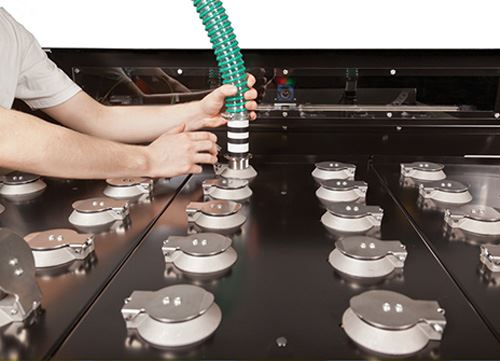
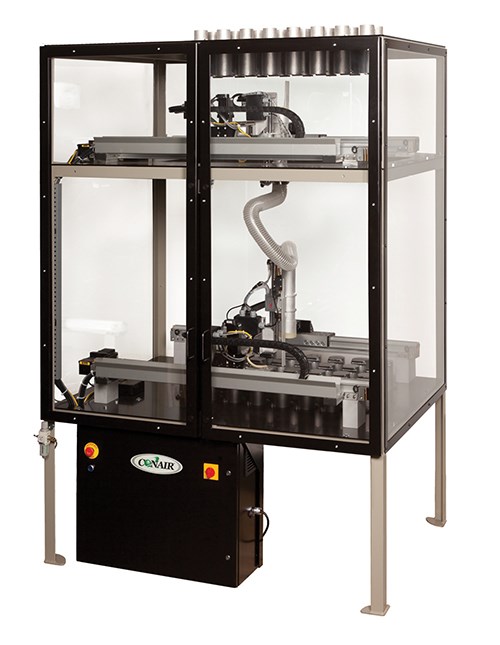

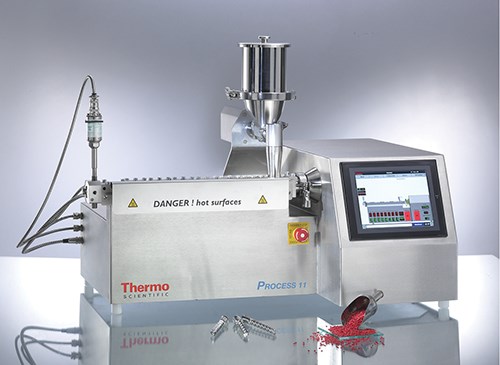
















.png;maxWidth=300;quality=90)






